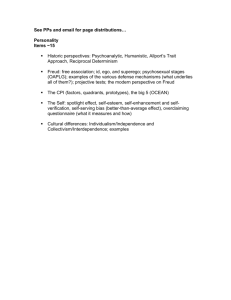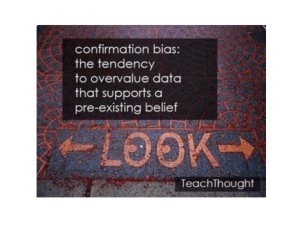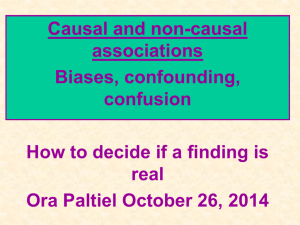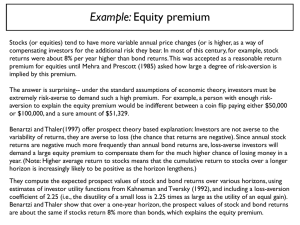Critical Thinking in Cross
advertisement
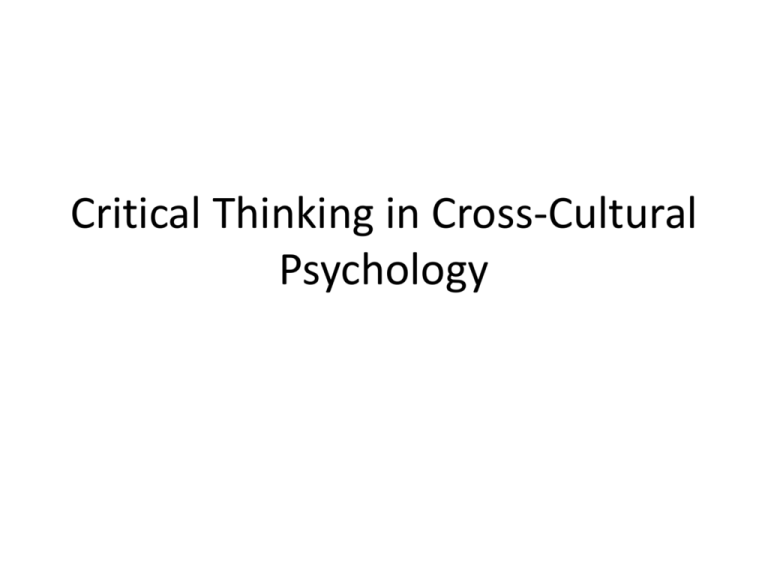
Critical Thinking in Cross-Cultural Psychology The Evaluative Bias of Language • No clear distinction between objective description and subjective evaluation – Words we choose reflect our value system – More so with objects than people – Values both shape and are shaped by our use of language. – Examples of differences in perspective • • • • • Old or Mature Obsessed or Committed Reckless or Brave Narcissistic or High Self-Esteem Dependent or Loyal Differentiating Dichotomous Variables and Continuous Variables • Dichotomous Variables- when phenomena in the world can be divided into two mutually exclusive categories (Heads or tails, Pregnant not pregnant) – Very Black and White • Continuous Variables-phenomena that consist of an infinite number of points between two polar opposites. (Individualism or Collectivism, Conservative or Liberal, Introverted or extroverted) – Shades of grey • Most phenomena related to people are continuous variables Similarity Uniqueness Paradox • Determining the similarities and differences between any set of events is dependent on the perspectives from which you choose to view them. • Always compare and contrast to understand why you are looking from the perspective you choose to view The Barnum Effect • Barnum Statement- a personality description of a particular individual or group that is true of practically all human beings • The Barnum Effect- refers to people’s willingness to accept the validity of such overly inclusive and generic appraisals • “There is a sucker born every minute” • http://www.youtube.com/watch?v=z11DeKK1 3vM&feature=related The Assimilation Bias • In general we do not make appropriate use of Assimilation and Accommodation strategies as defined by Piaget. • Usually go the assimilation route more than the accommodation route. – We like to make data fit our schema – Generates bias The Representativeness Bias • We often times need to make quick decisions about the world we live in • Use heuristics to do so (Tversky and Kahneman, 1974) • Trade off results in greater speed in decision making, but less accurate decisions – Representative Heuristics – – – – – – Most basic Involves judging the likelihood that something belongs to a particular category Leads to stereotyping Can produce systematic errors called representative bias Still produce more right answers than wrong ones, which is why we use them. Most dangerous when prototype categories exist with regards to particular groups of people. » A class divided The Availability Bias • Most powerful impressions come from events that are particularly vivid – Availability Heuristic (Tversky and Kahneman, 1973) • The easier to retrieve, the more likely we are to think it occurs frequently • Can result in systematic errors in making judgments called availability bias Fundamental Attribution Error • What causes people’s behavior? – Dispositional Attributions-Internal – Situational Attributions-External • We are prone to attribute behavior to internal factors more than external factors – Called Fundamental Attribution Error • What causes this? – Cognitive Biases-derive from our limited capacity to process information – Motivational Biases-derive from our desire to satisfy our own personal needs » Very common in western culture because of our belief that we are in control • We have great difficulty accepting fairness and injustice in life (Lerner, 1970) • Ex (rape victims act seductively, homosexuals brought aids on themselves) Self-Fulfilling Prophecy • Perceiver’s assumptions about a person can cause a person to meet those assumptions • Rosenthal and Jacobson 1968- Teachers told students expected to be intellectual bloomers by test/Students actually bloom • Always remember that we are effected by others as well. Correlation • Statement about the relationship and association between two variables • Does not imply causation – Unidirectional Causation • Does A cause B? • Does B cause A? – Bidirectional Causation • Do A and B cause each other? • Does C cause A and B? – Multidirectional Causation • Could there be a combination of these causal relationships? • Post hoc error (assuming that because B follows A, A caused B) often occurs because of parataxic reasoning (assuming events are causally linked because they happen in a close time frame The Naturalistic Fallacy • Equating our description of what IS with what OUGHT to be • Confusing an objective description with Subjective Value Judgment • Four Variant of the Fallacy – – – – Common=Good Uncommon=Bad Common=Bad Uncommon=Good • Just because something is true of nature, that does not make it right – Evolutionary Psychology The Belief Perseverance Effect • Clinging to beliefs in spite of evidence to the contrary

